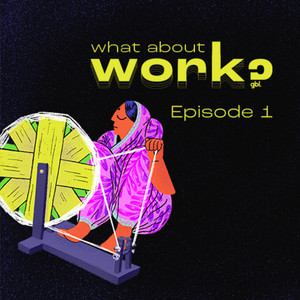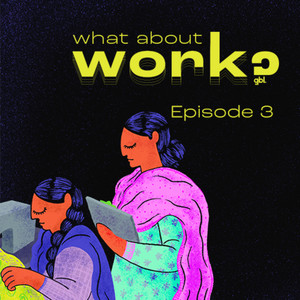In the second episode of What About Work? we discuss the importance of soft skills in a labor-intensive factory environment. Soft skills are well recognized, but are they also important on factory floors in a blue-collar context?We discern their significance in the blue-collar setting by understanding how workers tend to take the social norms they witness outside as their biases in the workplace, necessitating soft skills intervention.
What are the consequences of soft skills for workers and for firms? We get an all-encompassing view of it from the factory workers as well as researchers.
Transcript
Hello! And welcome to What about work? An audio series produced by Good Business Lab.
Good Business Lab seeks to globally transform the lives of low-income workers through rigorous research and evidence-based solutions.
What about work? talks about the past and current experiences of workers in labor-intensive industries and other emerging sectors across geographies. Be it garment, automobile, fast food, platform gig work or any other.
Our first episode dove into the garment sector. How it has changed. How it hasn’t. And how the lives of countless women across South Asia are delicately woven to it.
This second episode will zoom into an often understudied aspect of the daily grind workers experience. Soft skills. Soft skills impact production and productivity. They affect the mental health of workers. Yet, they continue to be overlooked.
Think about your own workplace. A conflict that wasn’t handled well. A must-do that didn’t quite get done. Or even something small like a lost email. The responses to all of these matter. They can have an incredible impact on our experience of going to work.
Communication, problem-solving, time management, leadership qualities among others are always necessary professional skills. The difficulty is that it is more obvious when the people around us lack these soft skills than when they exhibit them.
When it comes to the high-pressure, high-stakes environment of labor-intensive industries, soft skills can be an important prism to understand existing inequities and how to solve them.
But let’s pause for a moment. Before we unpack the role of soft skills in blue-collar settings, let’s
Smit G: Imagine a traditional factory setting where, for example, there are production lines…
That’s Smit Gade, the Associate Director of Research and Data at Good Business Lab.
Smit G: Let’s talk about the garment industry, where you could see around 30 to 50 people working on a production line where they are essentially producing one piece of garment. For example, you can start by deconstructing the shirt you’re wearing. Cut into different pieces. So somebody is assigned to stitch a sleeve. Everybody does that, and it becomes an assembly line where the end product is a shirt. Now that you have that in mind, think about what people value in these lines.
Now let’s think about in what situations soft skills can come into play.
Smit G: If you haven’t received enough pieces from the operator behind you or there is a small issue that comes up…
and small issues can quickly add up.
Smit: In these factories, every minute is converted into productivity. Any delay in your work is hampering people. If there are issues that need to be flagged, corrected, or highlighted, somebody needs to be able to communicate that. And that becomes a very important skill. I think what people haven’t realized is that there are humans behind this hard skill of stitching. That aspect of it is, I think, why soft skills are important.
A manager at a Delhi factory’s Organizational Development team puts it in clear terms.
Reena P: When a worker is coming with a gate pass form then supervisors would immediately start trying to avoid them because they know they are going to ask for a leave. They would keep walking from here to there on the factory floor to avoid the worker and the worker keeps following them.
Gate pass forms are what workers need to leave factory premises during work hours. Think about that situation for a second. What would you do if you had an emergency, your manager was hiding from you, and you were unable to leave your workplace? It would probably frustrate you. Make you feel like not working there anymore.
Things like this become especially tense in the garment sector where the workforce is predominantly women but supervisors are largely men. Also known as the sticky floor syndrome.
Smit G: Essentially, gender dynamics and power dynamics come into play, and sometimes people kind of take what they see around them as the norm—many times what they see in society as the norm. So if a society is unequal around you, you take those biases to your workplace. And that is very evident in factory settings, where a lot of women are shouted at by the male supervisors. So the shouting itself, compounded by the fact that it’s done by your supervisor, who is a man in many instances, kind of adds different layers to this behavior. In such cases, soft skills become very important. A lot of times, these training sessions are not provided because people don’t think they are important. So, for example, you need to kind of coach or train a supervisor to behave in a certain way. Let them understand what the norms are that need to exist within a factory, how to behave, and that there are alternate ways of dealing with the situation.
Chief Development Officer & Co-Founder of Good Business Lab, Achyuta Adhvaryu believes that
Achyuta A: I think people are creatures of their environment. The norms that govern how I’m supposed to do things kind of influence how I think about myself and my role. So, you know, it’s really hard to then sort of come out in that environment and say, “No, you know, we need to think about things differently, and maybe these other skills are really important.” I think both workers and employers often have this kind of paradigm. You know, this is low-skill work; this is technical work. I’m just supposed to show up here and do my stitches and then leave; you know, I think that’s the sort of overriding norm. And so it’s hard to break out of that. I actually even remember having conversations when we were doing some focus groups and asking women workers, What makes a good supervisor? And do you envision women being good supervisors because it’s not the norm in this industry to have women as supervisors? And a lot of people said, “I don’t think women would be good supervisors, and I think the reason is that women don’t know how to yell at people like men do. Our male supervisors feel okay yelling at us, and I think that’s what gets the work done.” So it’s a really startling thing to hear from women themselves. Everyone’s under time pressure, everyone’s under production pressure, and there’s a certain, natural instinct if you’re under that pressure and don’t have ways of dealing with your emotions, your stress, or the anxiety that it creates, in a productive way, I think the natural tendency is, you know, I’m just going to take it out on the next rung down, and that creates this cycle of abuse or harassment that’s then just taken as the norm and even kind of associated with productivity. It’s almost a positive thing that you need to yell to get faster work out of your employees. No one has taken a step back in that setting to say, “Wait a second. Do we actually need to yell?”
What would you do if your manager yelled at you? Would it impact your mental health? Would it make you work better? These are questions that workers in fast-paced factory environments don’t have time to ask. But that doesn’t mean they shouldn’t be asked.
In this intense and intensive work culture, soft skills can change things. Even then, supervisors rarely possess them. Why?
Smit G: Many times when factories are choosing supervisors, which is a technical and managerial position, a lot of times these people are promoted who are essentially good technical workers. This is not just common in garment factories, but in many cases, if you are a good employee or a technically strong employee, you get promoted to a managerial position. The job then becomes managing workers. So many times, workers who come in will not be formally trained in managerial ways. So they will be trained on: How do you do production? How do you set up a line? What are the technical details? However, there is no formal training for, say, how to manage workers. If somebody is falling behind, how do you help them? How do you address that situation? So many times, what they have learned is what they have seen their supervisors do, and then it persists. So when you are hiring, getting the right people might be an issue where you are promoting based on the talent they have but not on the talent that they would require for the job. Also, management faces time constraints. They don’t have the kind of bandwidth to think through some of these issues. But also, it’s not recognized that they need these things because it’s not something that, unless carefully measured, you can show on paper, whereas if something is a hard skill, you can easily measure it. For example, to determine how good a technical worker is, they’ll typically do these sessions where people will kind of give them different tasks and assess them. Then you can get hard numbers like, “Oh, this worker is like 80% productive,” or “This worker is 60% productive,” versus soft skills, which are by their nature difficult to measure and put hard numbers on them.
Achyuta A: And we’ve always thought that this is potentially a missed opportunity in a lot of settings, one for the individual, the worker themselves, because soft skills are, you know, an incredibly important transferable skill that you can use anywhere you go. So it doesn’t matter whether you’re a garment operator or a customer service person, or, whether you’re working in a factory or a restaurant, or, you know, wherever life may take you, these skills end up being really important and valuable. But also from the perspective of the firm, it’s true that if we could have more productive workers by giving them some of these skills, and if those workers stayed around more as a result of, you know, training programmes, et cetera, that could be really valuable to the firm.
But their importance is harder to capture in concrete numbers. Harder but not impossible.
Here’s Good Business Lab’s Senior Research Associate, Madhukari Mishra on the increase soft skills training can create in terms of productivity.
Madhukari M: A study in a Chilean retail firm showed that training managers and sales personnel in leadership and communication skills improved not just individual-level productivity but also sales. In fact, the study also showed that when you train both the managers and the sales personnel, sales increase more than when you train just the managers.
But can this also work for factories?
Madhukari M: A study in the garment factories in Bangalore that involved an 80-hour-long intervention with training in time management, problem-solving, decision-making, and financial literacy observed a large and persistent impact on productivity.
Ok, so there’s some good signs. But how does this pan out realistically? How do workers respond to training that targets soft skills? Something that isn’t valued or even understood entirely.
Reena P: The supervisors were not immediately comfortable when they came to the training. Initially, they were saying that we don’t need a training program because if we sit in the training, our work will suffer and we will not be able to achieve our target. Because our main motto is to achieve the given targets instead of any training program.
This manager runs a soft skills training program developed by Good Business Lab and designed in collaboration with Options and Solutions, a consultancy firm located in Bangalore, India. The program, Supervisors Transformation Into Change Holders, or STITCH, covers a range of topics focused around 4 key modules: me as a person, me as a supervisor, me as a team member, and me as a leader. The training lasts for around 6-7 months and touches on issues like self-esteem, gender sensitivity, problem-solving, planning, and preventing workplace harassment.
Reena P: After the second session (of the STITCH training programme), I was able to see that those who were not participating started to build a connection with the content we were giving them. Is it really helpful to them? And then slowly they started connecting it: that yes, this is what we are learning; this is cross-learning from across the sewing floor and the finishing floor; quality supervisors were also there. So they were sharing because questions were asked by them and responses were also given by them as a team. Just like when people ask questions and other team members respond, making them feel more secure because other people are here to support them.
Vasanth: The STITCH programme taught us everything from the time we get to the factory, to how we plan our work for the day, to how we first speak to the workers at the start of the day, to how we delegate work to the workers.
That’s Vasanth Kumar. A supervisor at a large garment factory in Bangalore who went through STITCH training in 2017.
Vasanth K: It taught us what to do when production targets were low. It also taught us what to do when production targets were very high and how to reach out to other departments in such a circumstance. It taught us about a lot of these things, like production quality and how to speak to people. The program was such that we would have two-hour classes on a particular day covering a specific topic. We would learn about quality management. It taught us to truly empathize with and understand the workers. For instance, if someone was not meeting their targets, perhaps they had a personal reason why that was the case. We were encouraged to understand these issues. And thus, we developed a very personal relationship with the workers. It also taught us the importance of respect. Whoever joins the factory floor, be it a manager, a worker, or a helper, you must absolutely give them respect.
Respect. Like Vasanth said, you should cultivate and practice it when working with other people.
So what are some other real gains of such upskilling programs?
Achyuta A: The firm receives a lot of this benefit, and the gain in productivity is sort of larger than the gains in income that we see. And in some sense, the question is: how is this shared across workers and the firm? or supervisors in the firm, of whom I think most immediately because they’re the ones receiving the training, but also workers because, ultimately, we care about how this affects the sort of well-being and incomes of front-line workers as well. And along both of those lines, we do see increases in the salary of supervisors as well as the sort of incentives or bonuses paid for achieving certain productivity marks that are given to both supervisors and workers. So, you know, in some cases, we do see gains for both supervisors and workers; those gains are pretty substantial, even if you just count them as the sort of major benefits of the program. Let’s ignore productivity for a second and just say, you know, what happens to incomes. This program would be immensely valuable just as, you know, a way to increase incomes.
This is meaningful for low-income workers. More money in your hand can make a world of difference at times when you face a severe cash crunch.
Despite being largely unseen in blue-collar work, soft skills can have very real consequences for blue-collar workers. Whether they are present or absent. The goal then should be to ensure their intentional and impactful presence. To make certain that firms bolster their ambitions while workers continue to benefit from a safe environment. Soft skills should not be ignored when considering the wellbeing of workers.
Our next episode will delve into what soft skills can do for women in particular to break the sticky floor syndrome. Can they support more women climbing that ladder? Experts- both from research backgrounds and the blue-collar workforce will weigh in on the answer. So don’t forget to tune in to the third episode!
Thank you for listening to What about work?.
We always welcome constructive feedback. Have anything you want to say? Drop us a message @goodbusinesslab on Twitter, Instagram, or LinkedIn. You can also visit our website goodbusinesslab.org to learn more about our approach to worker wellbeing.




